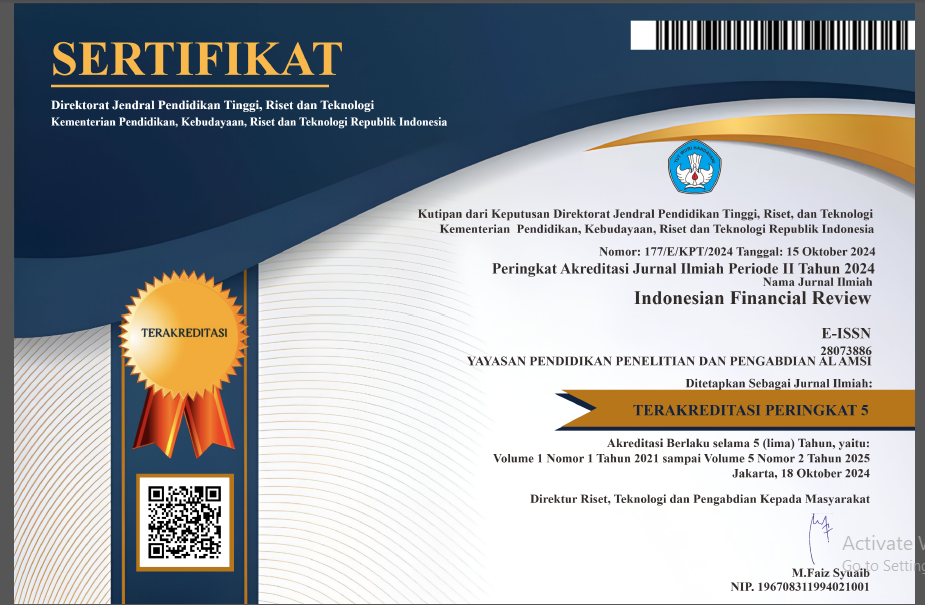The Impact of Information and Firm Size on Earnings Management in Indonesia’s Primary Consumer Sector Companies
DOI:
https://doi.org/10.55538/ifr.v5i1.50Keywords:
Information Asymmetry, Firm Size, Earnings ManagementAbstract
This study examines the influence of information asymmetry and firm size on earnings management in Indonesian listed firms. Using panel data analysis, the research evaluates both individual and joint effects of these variables. Descriptive statistics indicate a moderate level of earnings management, with firms exhibiting both income-increasing and income-decreasing adjustments. The results of hypothesis testing reveal that information asymmetry alone does not significantly affect earnings management (p = 0.1764), while firm size has a significant negative effect (p = 0.0001), suggesting that larger firms engage in less opportunistic reporting. However, the F-test shows that information asymmetry and firm size jointly have a significant impact on earnings management (p = 0.036), explaining 34.72% of the variation in the dependent variable. These findings align with agency theory, which emphasizes managerial discretion under information imbalance, and signaling theory, which highlights the strategic use of earnings to communicate firm performance. The study underscores the importance of governance and monitoring mechanisms in mitigating earnings manipulation in Indonesian firms.
References
Adewunmi, O. (2024). Earnings quality as a function of capital structure and financial signals. Journal La Bisecoman, 5(1), 12–25. https://newinera.com/index.php/JournalLaBisecoman/article/view/2292
Al-Malkawi, H. N. (2023). Earnings management of acquiring and non-acquiring companies: The key role of ownership structure and national corporate governance in GCC. Journal of Transnational Management, 28(2), 145–162. https://doi.org/10.1057/s41310-023-00220-5
Adiwibowo, I. (2018). The effect of corporate social responsibility disclosure and firm size on earnings response coefficient with profitability as a moderating variable. Diponegoro Journal of Accounting, 7(2), 1–15.
Botosan, C. A. (1997). Disclosure level and the cost of equity capital. The Accounting Review, 72(3), 323–349.
Cai, C. X., Keasey, K., & Short, H. (2006). Corporate governance and information asymmetry in the UK small firms sector. Accounting and Business Research, 36(1), 67–87. https://doi.org/10.1080/00014788.2006.9730005
Dechow, P. M., Sloan, R. G., & Sweeney, A. P. (1995). Detecting earnings management. The Accounting Review, 70(2), 193–225.
Faradhifa, C., & Handayani, A. (2023). Earnings management in view of information asymmetry, audit tenure and company size: An empirical study. Jurnal Riset Akuntansi dan Auditing, 11(2), 134–146. https://doi.org/10.55963/jraa.v11i2.657
Farichah. (2017). Pengaruh earnings management terhadap kualitas laba dan nilai perusahaan sebelum dan sesudah konvergensi IFRS. Jurnal Akuntansi, 21(2), 275–290.
Fraditya, D. (2023). Earnings management and earnings quality in manufacturing companies listed on the Indonesia Stock Exchange. Jurnal Ekonomi dan Bisnis, 26(1), 112–127.
Isnawati, M., Ulupui, I. G. K., Mardi, & Murdayanti, Y. (2024). Pengaruh asimetri informasi, ukuran perusahaan dan corporate governance terhadap manajemen laba pada sektor konsumsi (BEI) tahun 2019–2022. Jurnal Akuntansi, Perpajakan dan Auditing, 4(2). https://doi.org/10.21009/japa.0402.05
Jensen, M. C., & Meckling, W. H. (1976). Theory of the firm: Managerial behavior, agency costs and ownership structure. Journal of Financial Economics, 3(4), 305–360.
Mahendra, A., & Daljono. (2023). The effect of financial performance, firm size, and corporate governance on firm value with sustainability disclosure as a moderating variable. Diponegoro Journal of Accounting, 12(3), 1–14.
Nazir, M. S., & Afza, T. (2009). Impact of aggressive working capital management policy on firms’ profitability. The IUP Journal of Applied Finance, 15(8), 19–30.
Nasution, F., & Pratiwi, N. (2023). Earnings management practices in listed firms: The role of accounting flexibility and audit quality. Jurnal Akuntansi Multiparadigma, 14(1), 32–48.
Scott, W. R. (2015). Financial Accounting Theory (7th ed.). Toronto: Pearson Education.
Sekrihwati, R., & Lestari, N. P. A. (2021). The influence of company size, managerial ownership, profitability, and information asymmetry on earnings management in leading manufacturing companies in Indonesia. International Journal of Research – GRANTHAALAYAH, 9(10). https://doi.org/10.29121/granthaalayah.v9.i10.2021.4295
Setiawati, S., & Syaiful, S. (2022). Pengaruh asimetri informasi, ukuran perusahaan dan kepemilikan manajerial terhadap manajemen laba. Journal of Culture Accounting and Auditing, 1(2), 112–124. https://doi.org/10.30587/jcaa.v1i2.4446
Shukla, A., & Kumar, R. (2022). Scaling the signal: How firm size moderates the effects of financial disclosures on market and value metrics. Journal of Business and Financial Management, 7(1), 33–48. https://jbsfm.org/vol7no1/scaling-the-signal-how-firm-size-moderates-the-effects-of-financial-disclosures-on-market-and-value-metrics
Wareza, M. (2019, September 30). Ernst & Young ungkap dugaan rekayasa laporan keuangan AISA. CNBC Indonesia. https://www.cnbcindonesia.com
Winarno, W. W. (2022). Earnings management, board of directors, and earnings persistence (Indonesian evidence). Jurnal Akuntansi dan Auditing Indonesia, 26(2), 141–152. https://journal.uii.ac.id/JAAI/article/view/23295
Downloads
Additional Files
Published
How to Cite
Issue
Section
License
Copyright (c) 2025 Muliyani Muliyani, Syamsudin Syamsudin

This work is licensed under a Creative Commons Attribution 4.0 International License.















